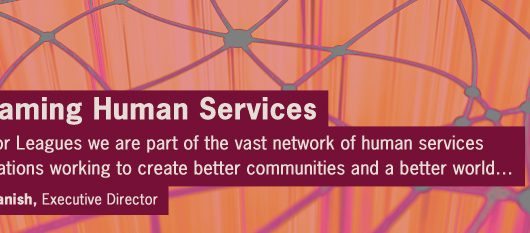Last week I attended part of the Social Innovation Summit 2013, which was held at Stanford. I’ve been stewing about the fact that so many issues we, and many, many other organizations have been addressing for decades, persist. So I headed off to Stanford to spend a day learning more about what those viewed as social innovators today are doing to create change.
I learned some good “textbook” things. I can hardly wait until February 2014 when the book, Scaling Up Excellence, can be loaded into my e-reader. One of its authors, Stanford Professor Robert Sutton, gave us a 10-minute overview of six steps to guide scaling innovation. I am certain that as we scale the work of our 13 Action Learning Teams (certainly innovation on a grand scale) addressing League membership, governance and community impact, it will be useful. I loved the overarching message, which was that scaling excellence requires “spreading and sustaining a mindset not just a footprint.”
But what I really took away from the Summit was not a list of six steps, or mega trends that will impact all we do in 2050, or anything that tangible. The time spent in McCaw Hall reminded me that innovation happens when passion meets purpose.
I was humbled by speaker after speaker…Starting with Jane Chen, a recent Stanford MBA, who founded Embrace (embraceglobal.org.). She has created affordable technology for people living on $1/day to improve the survival rate of low birth-weight and premature babies. The statistics are staggering. Twenty million low birth weight and premature babies are born each year. Four million die in their first month of life and many who survive suffer from diabetes, heart disease and low IQ. The problem is keeping the “premies” warm. The Embrace product looks like a sleeping bag, can be used without electricity and is a low-cost alternative to incubators.
Then there was Jake Harriman, a former U.S. Marine, who founded Nuru International (nuruinternational.org) while at Stanford Business School. He came to believe that “…extreme poverty is a contributing factor to the causes of 21st century terrorism and insurgency, and that a reduction in extreme poverty will impede their proliferation.” He defines “poverty” as more than the standard $1.25 a day or less, to a broader definition. “Poverty is a lack of meaningful choices for basic human rights.” What his organization does is train and empower local leaders in the most rural, remote areas, and these leaders become the catalysts for change. It strikes me as a modern take on “teaching someone to fish…”
And there was Somaly Mam, and her Somaly Mam Foundation (somaly.org.). You may have read about her story in Nicholas Kristof’s book, Half the Sky. She survived sex slavery herself in Cambodia, and now works to end modern day slavery and to empower survivors.
When each of these people spoke, there was a fire in their eyes, conviction in their voices, authenticity in their words and strength in their gestures. Each was looking for new, better, different ways to create change. Their stories connected with me on an emotional, gut level. And so I think about Junior Leagues as we embrace issue-based community impact and new membership and governance models. The words themselves are not inspiring. But each of us needs to internalize what these changes mean for us and our communities. I hope we can each look at the opportunity to tackle an issue with passion, to be passionate about each member and to be leaders with a passion that is fueled by the need to create a better community and a better world. That’s passion with a purpose. We need to find, and use, the passion within, and to inspire passion in others. Perhaps Professor Sutton actually said it best: “It is a mindset.”


1 comment
That, passion with a purpose sounds like a great tag line for the leagues strategic initiatives. Half the sky was an amazing book!
Great commentary!